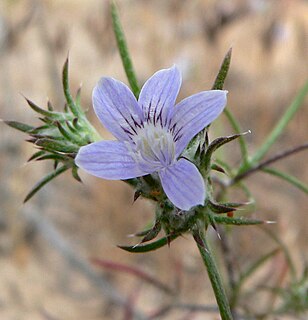
Eriastrum is a genus of flowering plants in the phlox family which are known commonly as woollystars. These wildflowers are somewhat diverse in appearance but are usually erect, thin-stemmed herbs which bear purple to white blooms. Most species have inflorescences which are webbed with a woolly mesh of white fibers. Woollystars are native to western North America.
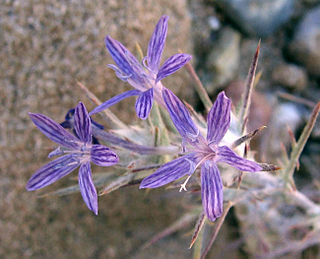
Eriastrum densifolium is a species of flowering plant in the phlox family known by the common name giant woollystar. This wildflower is native to California and Baja California where it grows in open areas such as sand dunes and dry washes. It grows on an erect stem with slightly hairy to densely woolly foliage, often giving the plant a dark gray-green color. The leaves are narrow and spike-shaped with pointed lobes. The top of each stem is occupied by a bunched inflorescence full of woolly leaflike bracts and funnel-shaped, flat-faced flowers. The flowers are each 1 to 3 centimeters long with a face up to three or four centimeters wide. The lobes are white to bright, striking blue, sometimes with longitudinal pinstripes. The stamens protrude from the throat.
Eriastrum luteum is a species of flowering plant in the phlox family known by the common names yellow woollystar and yellow-flowered eriastrum. This wildflower is endemic to California where it is known only from Monterey and San Luis Obispo Counties. This is a small annual rarely reaching the maximum 25 centimeters in height. It has occasional thin, threadlike leaves which are covered in a coat of woolly hairs. The inflorescence is a cluster of leaflike green or reddish bracts strung densely with cobwebby white wool and bearing bright yellow flowers. Each flower has five rounded lobes and long, protruding stamens with large anthers.
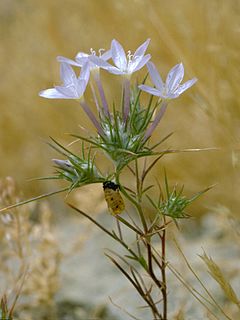
Eriastrum pluriflorum is a species of flowering plant in the phlox family known by the common names Tehachapi woollystar and many-flowered eriastrum.

Hymenoxys lemmonii is a species of flowering plant in the daisy family known by the common names Lemmon's rubberweed, Lemmon's bitterweed, and alkali hymenoxys. It is native to the western United States in and around the Great Basin in Utah, Nevada, northern California, and southeastern Oregon.
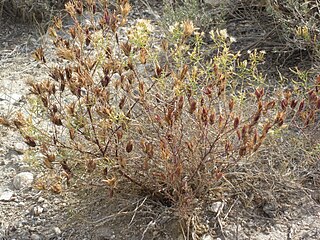
Cordylanthus ramosus is a species of flowering plant in the family Orobanchaceae known by the common name bushy bird's beak. It is native to the western United States where it grows in mountains and plateau, including the sagebrush of the Great Basin. It is an annual herb producing an erect, branching gray-green form, often tinted with red, becoming bushy at its most robust and appearing not unlike a sagebrush. The small leaves are narrow and linear or divided into several narrow, thready lobes. The inflorescence is a small spike of a few flowers surrounded by bracts which are linear or divided into narrow, thready lobes like the leaves. The bracts are faintly woolly and occasionally bristly in texture. The flower is one to two centimeters long with a hairy yellow pouch enclosed in darker, tougher reddish sepals. This plant had a number of historical medicinal uses for the Navajo people, who used it as an emetic.

Crepis acuminata is a North American species of flowering plant in the family Asteraceae known by the common name tapertip hawksbeard. It is native to the western United States where it grows in many types of open habitat.

Crepis intermedia is a North American species of flowering plant in the family Asteraceae known by the common name limestone hawksbeard. It is native to the Pacific Northwest, Columbia Plateau, Great Plains and Southwestern regions of western North America.
Eriastrum abramsii is a species of flowering plant in the phlox family known by the common name Abrams' woollystar. The epithet abramsii commemorates LeRoy Abrams. It is endemic to California, where it is known from the hills of the Coast Ranges in and around the San Francisco Bay Area. It is an annual herb producing a thin, usually woolly stem up to about 15 centimeters tall. The leaves are divided into several narrow, threadlike linear lobes. The inflorescence is a woolly cluster of narrow, leaflike bracts laced with webby fibers. The small flowers have yellow throats and white or blue corolla lobes.
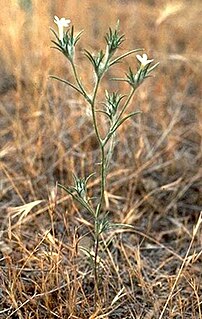
Eriastrum brandegeeae is a species of flowering plant in the phlox family known by the common name Brandegee's woollystar. It is endemic to California, where it is known from the chaparral and woodlands of the North Coast Ranges, generally on volcanic soils. There have been specimens collected from the San Francisco Bay Area which are closer to this species than other Eriastrum, but may actually be a new species. This is an annual herb producing a thin, usually woolly stem up to about 30 centimeters tall. The leaves are divided into several narrow, threadlike linear lobes. The inflorescence is a woolly cluster of narrow, leaflike bracts laced with webby fibers. The small flowers have white to light blue corollas.
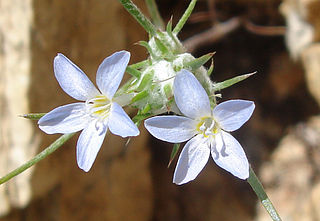
Eriastrum diffusum is a species of flowering plant in the phlox family known by the common name miniature woollystar. It is native to the southwestern United States from California to Texas, where it grows in many types of open habitat. This is an annual herb producing a thin, usually woolly stem up to about 20 centimeters long, growing erect or spreading outward. The leaves are divided into 2 to 4 narrow, threadlike linear lobes. The inflorescence is a woolly cluster of narrow, leaflike bracts laced with webby fibers. The small flowers are funnel-shaped, with yellowish throats and white to pale blue corollas.
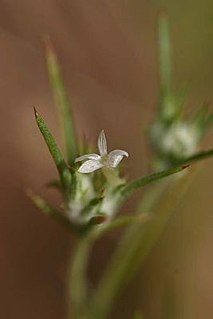
Eriastrum hooveri is a rare species of flowering plant in the phlox family known by the common name Hoover's woollystar. It is endemic to the South Coast Ranges of California from San Benito to Los Angeles Counties, where it grows in grassy open habitat. It is an annual herb producing a wiry, usually woolly stem up to about 15 centimeters tall. The leaves are linear and threadlike, less than three centimeters long, and sometimes divided into two thready lobes. The inflorescence is a woolly cluster of narrow, leaflike bracts laced with webby fibers. The flowers are white and just a few millimeters in length.
Eriastrum virgatum is a species of flowering plant in the phlox family known by the common name wand woollystar. It is endemic to California, where it is known the coastline and coastal mountain ranges of Monterey and San Benito Counties. It grows in chaparral and coastal and inland scrub habitat. It is an annual herb producing a thin, usually woolly stem up to about 40 centimeters tall. The leaves are narrow and thick, up to 5 centimeters long, and sometimes divided into two narrow lobes. The inflorescence is a woolly cluster of narrow, leaflike bracts laced with webby fibers. The flowers have yellow throats and bright blue corollas with lobes up to a centimeter long.

Constancea is a monotypic genus of flowering plants in the family Asteraceae containing the single species Constancea nevinii, which is known by the common name Nevin's woolly sunflower. It is endemic to three of the Channel Islands of California, where it grows in coastal scrub habitat. This is a small shrub or subshrub generally growing up to one or 1.5 meters tall, and taller when an erect form, with a branching, woolly stem. The whitish, woolly oval leaves may be up to 20 centimeters long and are divided into many narrow lobes with edges curled under. The inflorescence is a cluster of 10 to 50 or more small flower heads, each on a short peduncle. The flower head has a center of hairy, glandular, star-shaped yellow disc florets and a fringe of four to nine yellow ray florets, each about 2 millimeters long. The fruit is an achene a few millimeters long with a small pappus at the tip.

Lessingia lemmonii is a species of flowering plant in the family Asteraceae known by the common name Lemmon's lessingia. It is native to the western United States around the intersection of Nevada, Arizona, and California, where it grows in desert and other habitat with sandy soils. This is an annual herb producing gray-green woolly stems in a low clump just a few centimeters high to a relatively erect 40 centimeters tall. The leaves are narrow and small, under 2 centimeters long, with much larger leaves appearing around the base of the young plant and withering away early. The flower heads appear singly or in open arrays. Each head has a bell- to bullet-shaped involucre lined with hairy to woolly phyllaries. The head is discoid, containing no ray florets but many funnel-shaped yellow disc florets with long lobes. The florets often have white markings in the throats. The fruit is an achene with a whitish or brownish pappus of bristles.

Lessingia leptoclada is a species of flowering plant in the family Asteraceae known by the common name Sierra lessingia. It is endemic to the Sierra Nevada of California, where it is known from several types of local habitat. This is a slender annual herb growing erect and varying in size from just a few centimeters to nearly a meter tall, with long, spreading branches. It is very glandular and often hairy or woolly in texture. The upper leaves are up to 5 centimeters long, narrow and sometimes toothed or lobed; the lower leaves are longer and wither early. The flower heads appear singly or in small clusters. Each head is lined with woolly phyllaries. The head is discoid, containing no ray florets but many funnel-shaped pinkish, lavender, or light bluish-purple disc florets with large lobes. The fruit is an achene with a whitish pappus of bristles.
Lessingia virgata is a species of flowering plant in the family Asteraceae known by the common name wand lessingia. It is endemic to California, where it is known from the eastern side of the Central Valley and adjacent Sierra Nevada foothills. It is a woolly, glandular annual herb growing up to about 60 centimeters tall with slender, spreading branches. The upper leaves are no more than a centimeter long, while the lower ones are longer and sometimes divided into lobes or teeth. The flower heads appear singly in leaf axils, each lined with purple-tipped, glandular, woolly phyllaries. The head is discoid, containing no ray florets but a few tubular light lavender to nearly white disc florets with long, narrow lobes. The fruit is an achene with a whitish pappus on top.
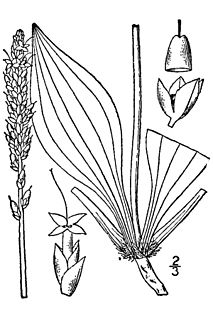
Plantago eriopoda is a species of plantain known by the common name redwool plantain. It is native to much of western and central North America from Alaska to the southwestern United States to the Great Lakes region, where it can be found in moist and wet habitat types, sometimes in alkaline soils. It is a perennial herb producing a clump of lance-shaped to narrow oval leaves up to 25 centimeters long. The leaves may have slightly toothed edges and often have a coating of woolly red hairs near their bases. The stemlike inflorescences grow erect to a maximum height near half a meter. Atop the peduncle of the inflorescence is a dense cylindrical spike of many tiny flowers. Each flower has a whitish corolla with four lobes each about a millimeter long accompanied by sepals covered with small bracts.

Packera eurycephala is a species of flowering plant in the aster family known by the common name widehead groundsel. It is native to a section of the western United States encompassing southern Oregon, northern California, and northern Nevada. It can be found in dry habitat types, often in disturbed areas, and it favors serpentine soils.
Trifolium andersonii is a species of clover known by the common names fiveleaf clover and Anderson's clover. It is native to the western United States, particularly the Great Basin and adjacent high mountain ranges, including the Sierra Nevada. It was named after Charles Lewis Anderson by Asa Gray.















